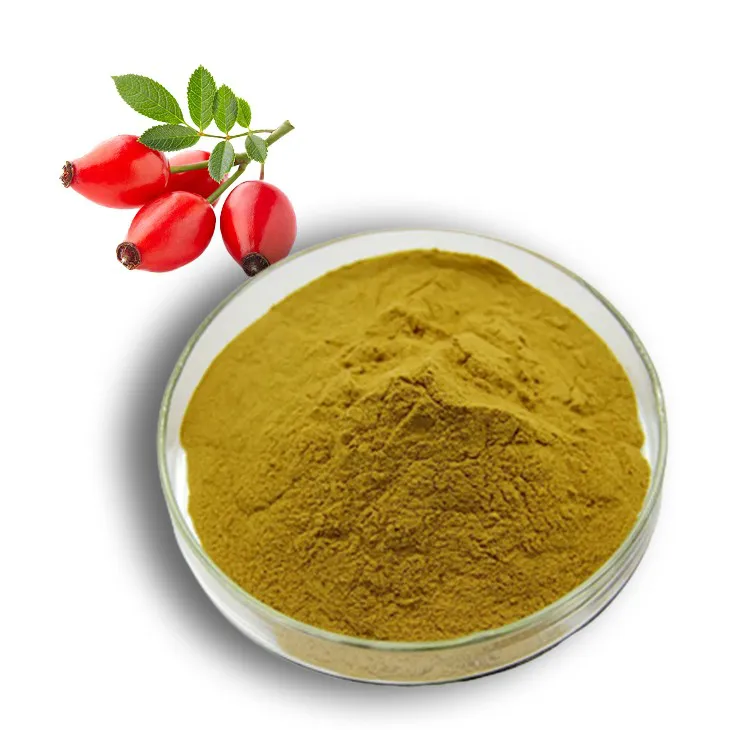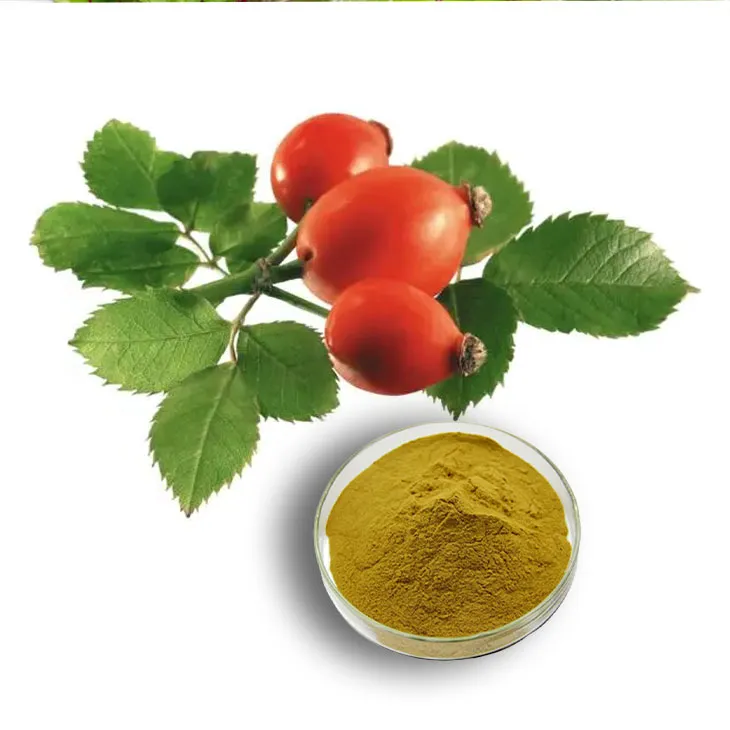- 0086-571-85302990
- sales@greenskybio.com
Optimal Bioavailability of Rose Hip Extract
2024-11-29

1. Introduction
Rosehip extract has emerged as a significant component in the health and wellness arena. It is rich in various nutrients such as vitamins, antioxidants, and essential fatty acids. However, the bioavailability of these beneficial compounds is a crucial aspect to consider. Bioavailability refers to the proportion of a substance that enters the circulation when introduced into the body and is thus available to have an active effect. Understanding the factors that influence the best bioavailability of rosehip extract is essential for maximizing its potential benefits in health applications.

2. The Source and Quality of Rosehip
2.1. Geographical Origin
The geographical origin of rosehips can significantly impact their quality and the bioavailability of their extracts. Rosehips grown in different regions may be exposed to varying environmental conditions, including soil quality, climate, and sunlight exposure. For example, rosehips from regions with nutrient - rich soil may contain higher levels of essential minerals and vitamins. In colder regions, they might develop higher concentrations of certain antioxidants as a defense mechanism against harsh environmental conditions. These differences in the chemical composition due to geographical origin can affect how well the body can absorb and utilize the compounds in the rosehip extract.
2.2. Rosehip Species
There are several species of roses that produce rosehips, and each species may have distinct chemical profiles. Some species may be richer in certain vitamins, while others may contain higher levels of fatty acids or polyphenols. For instance, Rosa canina, a commonly used species for rosehip extract, is known for its relatively high content of vitamin C and antioxidants. The specific species used for extraction can thus influence the bioavailability of the resulting extract. If the extract is rich in compounds that are more easily absorbed by the body, such as certain forms of vitamin C or highly bioavailable antioxidants, the overall bioavailability of the rosehip extract will be enhanced.
2.3. Harvesting and Storage
The time of harvesting and the methods of storage also play a vital role in the quality and bioavailability of rosehip extract. Harvesting at the optimal time ensures that the rosehips contain the maximum amount of beneficial compounds. If harvested too early or too late, the levels of vitamins, antioxidants, and other nutrients may be sub - optimal. After harvesting, proper storage is crucial to prevent degradation of these compounds. Exposure to heat, moisture, and sunlight can cause the breakdown of vitamins and antioxidants, reducing their bioavailability in the extract. For example, storing rosehips in a cool, dry, and dark place can help preserve their nutritional content and enhance the bioavailability of the subsequent extract.

3. Processing Techniques
3.1. Extraction Methods
There are several extraction methods available for obtaining rosehip extract, and each can have a different impact on bioavailability. Solvent extraction is a common method, where solvents such as ethanol or water are used to extract the active compounds from the rosehips. The choice of solvent can influence the solubility of different compounds and thus their bioavailability. For example, ethanol may be more effective in extracting certain lipophilic compounds, which could potentially enhance their absorption in the body. However, improper solvent extraction can also lead to the extraction of unwanted compounds or the degradation of some beneficial ones, thereby reducing bioavailability.
Supercritical fluid extraction is another advanced technique. This method uses supercritical fluids, such as carbon dioxide, under specific pressure and temperature conditions. It has the advantage of being a more selective extraction method, which can result in a purer extract with higher bioavailability. The mild extraction conditions of supercritical fluid extraction can help preserve the integrity of the bioactive compounds, making them more available for absorption in the body.
3.2. Purification and Concentration
After extraction, purification and concentration processes are often carried out. Purification helps remove impurities such as plant debris, pesticides, and other unwanted substances. A purer extract is more likely to have a higher bioavailability as it reduces the presence of substances that may interfere with absorption. Concentration of the extract can also impact bioavailability. By increasing the concentration of the active compounds, the body may be able to absorb a sufficient amount more easily. However, over - concentration can sometimes lead to the formation of aggregates or complexes that are less bioavailable, so careful control of the concentration process is necessary.

4. Additives and Their Impact
4.1. Excipients in Formulations
When rosehip extract is formulated into products such as supplements or pharmaceuticals, excipients are often added. These excipients can either enhance or reduce bioavailability. For example, some excipients can act as carriers, helping to transport the active compounds in the rosehip extract across the intestinal barrier for better absorption. On the other hand, certain excipients may interact unfavorably with the active compounds, causing precipitation or degradation and thus decreasing bioavailability. Common excipients include binders, fillers, and lubricants, and their selection and compatibility with rosehip extract need to be carefully considered.
4.2. Presence of Other Bioactive Compounds
In some cases, rosehip extract may be combined with other bioactive compounds in a formulation. The presence of these other compounds can have a complex impact on bioavailability. For instance, if another antioxidant is added, it may work synergistically with the antioxidants in the rosehip extract, enhancing the overall antioxidant activity and potentially improving bioavailability. However, there may also be cases where the different compounds compete for absorption pathways or interact in a way that reduces bioavailability. Therefore, the combination of rosehip extract with other bioactive substances requires careful study and optimization.
5. Potential Applications in Relation to Bioavailability
5.1. Nutritional Supplements
In the context of nutritional supplements, the bioavailability of rosehip extract is of utmost importance. If the extract has high bioavailability, it can effectively deliver its nutrients, such as vitamins and essential fatty acids, to the body. This can help address nutritional deficiencies and support overall health. For example, in cases where individuals have a low intake of vitamin C from their diet, a highly bioavailable rosehip extract supplement can be a valuable source of this vitamin. Moreover, the antioxidant properties of rosehip extract, when bioavailable, can help combat oxidative stress in the body, which is associated with various chronic diseases.
5.2. Cosmetics
Rosehip extract is also widely used in cosmetics due to its beneficial properties for the skin. The bioavailability of its active compounds in this context is relevant for achieving the desired skin - related effects. For example, if the fatty acids in the rosehip extract are highly bioavailable, they can penetrate the skin layers more effectively and provide moisturizing and anti - aging benefits. Antioxidants in the extract can also protect the skin from free - radical damage when they are available for absorption by the skin cells. Thus, formulators in the cosmetics industry need to consider factors that enhance bioavailability when developing products containing rosehip extract.
5.3. Pharmaceuticals
In the pharmaceutical field, rosehip extract may be investigated for its potential therapeutic effects. Bioavailability is a critical factor in determining the efficacy of any drug or active ingredient. If rosehip extract is to be used as a treatment for certain conditions, such as joint pain or inflammation, its bioactive compounds must be available in sufficient quantities in the body. Understanding the factors that optimize bioavailability can help in the development of more effective pharmaceutical formulations based on rosehip extract.
6. Conclusion
The optimal bioavailability of rosehip extract is a multi - faceted concept that depends on various factors. The source and quality of rosehip, including its geographical origin, species, and harvesting and storage conditions, set the foundation. Processing techniques, such as extraction, purification, and concentration methods, play a significant role in determining the bioavailability of the final extract. Additionally, additives and the presence of other bioactive compounds can either enhance or hinder bioavailability. Considering these factors is crucial when exploring the potential applications of rosehip extract in nutritional supplements, cosmetics, and pharmaceuticals. By understanding and optimizing bioavailability, we can fully harness the potential health and wellness benefits of rosehip extract.
FAQ:
What factors determine the bioavailability of rosehip extract?
The bioavailability of rosehip extract is determined by several factors. Firstly, the source and quality of the rosehip are fundamental. High - quality rosehips from a reliable source are more likely to have better bioavailability. Secondly, processing techniques play a crucial role. Different processing methods can either enhance or reduce bioavailability. Also, additives used during the production process can have an impact on how well the body can absorb the extract.
How does the source of rosehip affect its extract's bioavailability?
The source of rosehip is important for bioavailability. Rosehips from different regions may have different chemical compositions due to variations in soil, climate, and cultivation methods. For example, rosehips grown in nutrient - rich soil and optimal climate conditions may contain higher levels of bioactive compounds, which can lead to better bioavailability of the extract. Also, the species of rose used for the hips can vary in the types and amounts of beneficial substances they contain.
What processing techniques can enhance the bioavailability of rosehip extract?
Some processing techniques can enhance the bioavailability of rosehip extract. For instance, gentle extraction methods that preserve the integrity of bioactive compounds are beneficial. Techniques like cold - pressing or using solvents that do not damage the delicate molecules can help. Additionally, processes that break down the cell walls of the rosehip effectively can release more of the active ingredients, making them more available for absorption. Microencapsulation is another technique that can protect the extract during digestion and improve its delivery to the body's cells, thus enhancing bioavailability.
Can additives reduce the bioavailability of rosehip extract?
Yes, certain additives can reduce the bioavailability of rosehip extract. For example, some preservatives or fillers may interact with the bioactive compounds in the extract, either chemically changing them or preventing their proper absorption. If additives are not carefully selected, they may form complexes with the beneficial substances in the rosehip extract, making it difficult for the body to take up and utilize these compounds effectively.
What are the potential applications of rosehip extract based on its bioavailability?
Based on its bioavailability, rosehip extract has various potential applications. In the skincare industry, if the bioactive compounds are well - absorbed, it can be used for anti - aging products as it may help with collagen production and skin repair. In the field of nutrition, it can be formulated into dietary supplements. If the bioavailability is high, it can potentially provide antioxidant benefits, help with joint health, and boost the immune system more effectively. In the pharmaceutical field, it may be explored for the development of drugs for certain inflammatory conditions if the active ingredients can be delivered efficiently to the target tissues.
Related literature
- Bioavailability of Rosehip Extract and Its Impact on Health"
- "Optimizing the Bioavailability of Bioactive Compounds from Rosehip"
- "Rosehip Extract: From Source to Bioavailability and Applications"
- ▶ Hesperidin
- ▶ Citrus Bioflavonoids
- ▶ Plant Extract
- ▶ lycopene
- ▶ Diosmin
- ▶ Grape seed extract
- ▶ Sea buckthorn Juice Powder
- ▶ Fruit Juice Powder
- ▶ Hops Extract
- ▶ Artichoke Extract
- ▶ Mushroom extract
- ▶ Astaxanthin
- ▶ Green Tea Extract
- ▶ Curcumin
- ▶ Horse Chestnut Extract
- ▶ Other Product
- ▶ Boswellia Serrata Extract
- ▶ Resveratrol
- ▶ Marigold Extract
- ▶ Grape Leaf Extract
- ▶ New Product
- ▶ Aminolevulinic acid
- ▶ Cranberry Extract
- ▶ Red Yeast Rice
- ▶ Red Wine Extract
-
Nettle leaf extract
2024-11-29
-
Echinacea Extract
2024-11-29
-
Grapefruit Seed Extract Powder
2024-11-29
-
Sophora Flavescens Root Extract
2024-11-29
-
Acerola Juice Powder
2024-11-29
-
Europen Bilberry Extract
2024-11-29
-
Cassia Seed Extract
2024-11-29
-
Peppermint Oil
2024-11-29
-
Hesperidin
2024-11-29
-
Bitter Melon Extract
2024-11-29





















